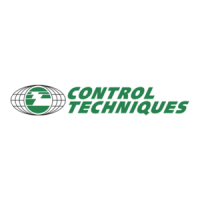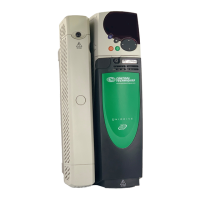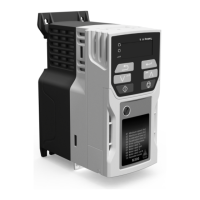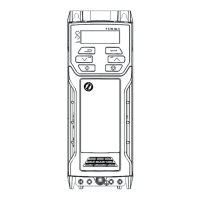
Do you have a question about the Control Techniques Unidrive 1 Series and is the answer not in the manual?
| Switching Frequency | 2 kHz to 16 kHz (Adjustable) |
|---|---|
| Storage Temperature | -40°C to +70°C |
| Type | AC Drive |
| Output Voltage | 0 - Input Voltage |
| Output Current | Depends on model |
| Output Frequency | 0 to 400 Hz |
| Communication Options | RS485 |
| Protection Class | IP20 (standard) |
| Protection Features | Overcurrent, Overvoltage, Undervoltage, Overtemperature, Short Circuit |
| Overload Capacity | 150% for 60 seconds |
| Humidity | 95% RH (non-condensing) |
| Enclosure Rating | IP20 |
| Dimensions | Depends on model |
| Weight | Depends on model |
Crucial safety warnings, electrical safety, system design, environmental limits, and compliance.
Ratings, model numbers, variants, operating modes, and drive features.
Guidance on mounting, enclosure, ventilation, and RFI filters.
Power connections, supply requirements, motor protection, and EMC compliance.
Initial steps for setting up and operating the Unidrive, including keypad and menu navigation.
Detailed descriptions of Menu 0 parameters for quick and easy setup.
Steps for starting and commissioning the motor in various operating modes.
Fine-tuning parameters for optimal motor performance and drive efficiency.
Using pre-programmed application macros to simplify setup.
Comprehensive reference for all drive parameters, organized by menu.
Detailed specifications including ratings, dimensions, EMC, and environmental data.
Information on interpreting drive status, alarms, and trip codes.
UL file number and requirements for UL compliance.
Hazards associated with high voltages and extreme care needed when working with the drive.
Responsibilities for safe installation, system design, and personnel training.
Guidelines for operating the drive within specified environmental conditions.
Installer responsibility for complying with relevant national regulations.
Recommendations for motor installation and operation.
Precautions when altering parameters affecting drive operation.
Electrical specifications including nominal and output current ratings at various conditions.
Explanation of the Unidrive model numbering system.
How to identify the drive and understand its rating label.
Description of Unidrive Standard Industrial (STD) and overload capabilities.
Overview of available operating modes: Open loop, Closed loop vector, Servo, Regen.
Diagram and explanation of the drive's physical features and connections.
List of available optional modules for enhanced functionality.
References to other manuals and resources for further details.
Essential safety instructions for mechanical and electrical installation.
Key considerations for planning the drive installation, including access, environment, and cooling.
Procedures for safely removing terminal covers.
IP ratings for different drive sizes and configurations.
Steps for installing and removing option modules.
Details on surface and through-panel mounting methods for various drive sizes.
Guidance on enclosure layout and sizing for optimal performance and safety.
Ventilation requirements, especially for Size 5 power module.
Dimensions for fabricating baffle plates for through-panel mounting.
Maximum ambient operating temperature and derating information.
Available RFI filters, their part numbers, and specifications.
Location and torque settings for power and ground terminals.
Recommended checks for ensuring drive and installation reliability.
Wiring diagrams and safety precautions for power connections.
Specifications for AC supply voltage, phase, imbalance, and frequency.
Information on DC supply and DC bus paralleling configurations.
Typical and maximum continuous input current ratings.
Information on motor cable length, protection, and thermal protection settings.
Details on braking resistor values and setup.
Information on ground leakage current and RCD suitability.
Guidelines for ensuring compliance with EMC standards.
Specification and default functions of control terminals.
Explanation of the drive's display indicators and status messages.
How to use the drive's keypad for navigation and control.
Overview of the drive's parameter menus and navigation.
Shortcuts for faster parameter navigation and editing.
Commonly used parameters for basic setup.
Grouping of parameters by function for advanced setup.
Procedure for selecting and applying an operating mode.
How to save parameter settings.
Procedure for restoring default parameter values.
Managing security levels for parameter access.
Setup and connections for optional serial communication modules.
A table listing Menu 0 parameters with their ranges and defaults.
Detailed explanations of each parameter within Menu 0.
Basic connections and minimal parameter settings for running the motor.
Step-by-step commissioning for Open loop, Closed loop, and Servo modes.
Commissioning using PC software for different operating modes.
Setting motor parameters like current, poles, voltage, frequency, and power factor.
Controlling motoring, regenerating, and symmetrical current limits.
Configuring motor temperature monitoring and protection.
Adjusting the PWM switching frequency and its effects.
Encoder feedback limits and field weakening for high-speed operation.
Overview of application macros and their benefits.
Procedure for loading a macro into the drive.
Specific terminal configurations for different macros.
Logic diagrams and parameter changes for sample macros.
Highlights differences in macro functionality for Unidrive VTC.
Commonly used basic setup parameters.
Parameters for setting speed references and limits.
Parameters for configuring acceleration and deceleration ramps.
Parameters for encoder, resolver, and SINCOS feedback.
Parameters for motor current and torque control.
Parameters related to motor voltage, frequency, and power stage.
Parameters for controlling drive sequencing and logic.
Configuration of analog inputs and outputs.
Configuration of digital inputs and outputs.
Parameters for creating custom logic functions.
Parameters for setting programmable comparators and thresholds.
Parameters for digital lock and shaft orientation functions.
Parameters for configuring the PID controller.
Parameters for regenerative braking operation.
Configuration for small option modules like UD50, UD51, UD52, UD53.
Setup for large option modules.
Application-specific parameters.
Additional application-specific parameters.
Parameters for large option modules.
Electrical specifications, ratings, and dimensions for Unidrive.
Tables of input and output current ratings for various models.
Power dissipation values for different Unidrive models and switching frequencies.
Specifications for AC supply voltage, phase, imbalance, and frequency.
Recommendations for using line reactors to mitigate supply disturbances.
Motor specifications including phase and voltage.
Environmental operating conditions and cooling requirements.
Guidelines for storing the drive.
Derating requirements for operation at different altitudes.
IP ratings for different drive sizes and configurations.
Allowed number of starts per hour based on drive model.
Specifications for speed and frequency accuracy and resolution.
Physical dimensions for different Unidrive models.
Weight specifications for drive components.
Recommended cable sizes and fuse ratings.
Maximum permissible motor cable lengths based on switching frequency.
Specifications for the output sharing choke used with Size 5 drives.
Recommended braking resistor minimum resistances and power ratings.
Information on acoustic noise levels generated by the drive.
Torque settings for drive control terminals and RFI filters.
Details and ratings for available RFI filters.
Electrical ratings and dimensions for optional RFI filters.
Drive compliance with EMC standards and installation guidelines.
Table of trip codes, their diagnoses, and associated terminals.
Descriptions of alarm conditions and their meanings.
Explanation of the drive's status indications during normal operation.
How to access and interpret the drive's trip log.
AC supply requirements for UL compliance.
Tables showing maximum continuous output current ratings.
Placement instructions for the safety label for UL compliance.











